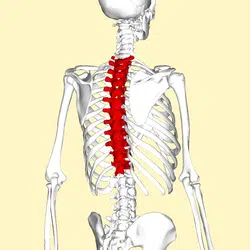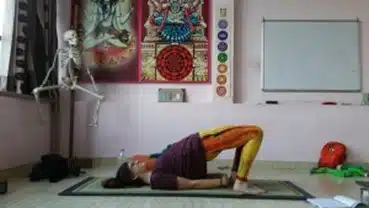Once upon a time, there was a very mysterious muscle. This psoas, pronounced ‘so-as’, buried deep into the body. The psoas, mostly known understood as a hip flexor (part of the mystery, but not the complete truth) was a very strong pair of muscles; deep in the belly, left and right of the spine. This hidden muscle is actually the only muscle connecting the upper body with the lower body and is the deepest skeletal muscle in the body. This information made me already very excited to learn more about the psoas, so if you are a little into anatomy or just interested; read what comes next!……..
The psoas’ position in the body
The psoas is actually a pair, situated left and right of the spine. The psoas starts at the lowest part of the thoracic part of the spine (the middle part), at disc T-12 for the experts, and continues until the top of the femur bone. The muscles are not only connected to disc T-12, but also to all the vertebrae of the lumbar spine (lower back). A strong and supple psoas will take care of good posture while sitting and walking, without pulling the back. When your psoas muscles are supple and balanced, your weight will be carried by your skeletal system, as it supposed to. When the psoas are contracted due to stress or sitting a lot during your waking hours, it is possible you pull the muscles while moving, causing yourself back pain or you will compress the discs in the lumbar part of the spinal column.


Left picture: the psoas on the left and right side of the spine
Right picture: the thoracic spine. The psoas start on the lowest vertebrae of this part of the spine and
connects on all the vertebrae of the lumbar spine before going down to the top of the femur bones.
Functions of the psoas:
The psoas is not only a very strong hip flexor, but also stabilizes the spine. Besides flexing the upper leg – taking it towards the pelvic area when you walk for example – and stabilizing your posture, the psoas has other functions as well:
Your psoas:
… takes care of a balanced skeleton
… has the potential to make the body strong and flexible
… contribute to range of motion and joint rotation
… is important to organ functioning (explained further down)
… benefits from breathing deep and smooth and your breath benefits from a supple psoas
… is connected with your emotion (explained further down as well)
… is connected with giving birth naturally
Strengthening the psoas
The psoas are a tricky muscle, in which the keyword is: ‘supple’. You can benefit from a strong psoas, but it should be flexible too, so it won’t contract too much. If you only focus on strengthening the psoas and won’t work on making this muscle pair flexible, it contracts again too much. This is what you want to avoid. It is all about balance (what isn’t actually). If you would decide to dedicate one of your yoga practices on the psoas, you could follow the following order of exercises:
- Exercises to strengthen the psoas
- Exercises to stretch the psoas (lengthening)
- Exercises to relax the psoas
Exercises that will make your psoas muscles stronger:
1. Boat (or easy boat, coming slightly up from the ground, starting lying down
2. Bridge (put a block between your feet and knees to keep the hips aligned with the femurs, knees and feet)
3. Lie down on the floor, point your toes and lift up one foot slowly, 10 centimeters of the mat. Keep the toes pointed. Keep the foot there, hold, lower and continue on the other side.

Bridge pose, to strengthen the psoas
Lengthening the psoas
The mysterious muscle pair can relax more easily when you also work on lengthening it. You could do for example a lot of low lunges to access and stretch the psoas, but only focusing on lengthening the psoas is not a good idea as well. When you only stretch and pull, there is no resistance that’ll protect the back and hips from sudden wrong movements. The same as with strengthening: it is all about balance. The benefits which you could receive from lengthening the psoas:
- More room to breathe
- More rest
- More room for your organs
Exercises that will help you to stretch the psoas:
- The most easy one: lie down on your back and breathe deeply into your abdominals. On the top of your inhale your breathing comes together with the diaphragm, the major breathing muscle, pushing your psoas down, lengthening it. So we can not only work on it by doing yoga postures, but also by breathing!
- Low lunge: go into it with a lot of concentration. First take in the points of the hips, steady the front feet and when you lengthen your spine on in inhale, you sink on an exhale. This way you stretch carefully the psoas from both sides, guided by your breath.
Relaxing the psoas
Relaxing the psoas maybe sounds the most easy, but this isn’t actually. The psoas is known to be contracted too much in almost every (western) body. These muscles are contracted almost since the day we are born. It starts by being moved around in a baby stroller, instead of being carried on the hip of your mother; which gives the body more movement. It is caused by always sitting on chairs all day long; our bodily functions are not designed to function well that way. It is even by using a western toilet bowl, were we are sitting again.
The psoas are also contracted a lot due to stress. When our body is in stress, it activates the ‘flight or fight response’ which causes the body to cramp or; contract. When you have a lot of stress, when are a little too busy in daily life, this ‘flight or fight response’ is activated permanently, putting your body in survival mode. When in survival mode, the cramped body chooses to only use the necessary organs and parts of the endocrine system to continue. So having a contracted psoas due to stress, is very unhealthy for the whole body.
Especially when you want to work on de-stressing the contracted psoas, the keyword is: relaxation. This is more difficult than it sounds. When lying in bed, you are even using the psoas, dreaming, tossing and turning. In order to give the psoas a break, there are a few exercises you can do:
- Lie on your back, place the feet against the outside of your mat and let the knees rest together. In this pose the hips are aligned, the whole back is on the floor.
- Lie on your back, place a bolster or a folded blanket under your popliteal and relax. Again the whole back should be on the floor, especially the lower back/lumbar spine.
- Practice Warrior 1 against a door post. It is important you keep the hips aligned, pointing forward, but this is often difficult. By placing your front against the frame of a door, you can lean without activating the psoas unnecessarily.
- Sitting crossed-legged, with a straight back. Your knees should always be lower than your hipbones, otherwise this exercise won’t relax the psoas. If necessary, tuck a pillow underneath your tailbone to lift you up a little higher.
The psoas and emotions
The reason the psoas can activate our ‘fight or flight response’ so easily is because it is very tightly bound to our emotions. The psoas is also called: ‘soul muscle’ or ‘seat to our soul’. It is buried deep in our body, connected to a lot of organs, the spinal cord which is connected to the nervous system and it also touches the solar plexus (which is the area of the stomach and the lower abdominals) where we store our energy and where we can hold onto negative emotions. When we are in danger and the ‘flight’-part is activated; we have the urge to wrap our body into a tiny ball. This is the psoas contracting. We also feel this way when we are sad, stressed, or dread to come out of bed. This is the psoas protection you against those things, which is natural if you would be in real danger, but can have to opposite effect when you keep on being stressed. The real protection is letting these negative feelings go, be relaxing the psoas. Of course this is easier said than done, but ‘practicing’ to relax the psoas is a good start to let all this negativity go. Sometimes we don’t even know we carry around negative energy, so a lot can come loose unexpectedly when you relax your psoas. Expect the unexpected and then let it go, let it slide off you. Try not to hold on. Practicing yoga can be a good addition on your journey to let go of old pain and the feel harmoniously in balance again. Every asana connected to the area of the psoas has the potential to release emotions, this is only ever a good thing.
Hope you enjoyed my latest post!
Love,
Annika